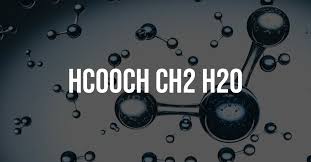The chemical equation involving formic acid (HCOOH) and ethanol (CH₃CH₂OH) represents one of the simplest and most important reactions in organic chemistry: esterification. When combined with water, these substances participate in an equilibrium process that forms ethyl formate and water. This guide explains how the reaction works, what it produces, and why it’s relevant in industry and education. Explore the reaction HCOOH + CH₃CH₂OH + H₂O to understand how formic acid and ethanol form ethyl formate. Learn the mechanism, conditions, and uses.
What Happens in This Reaction?
The overall balanced reaction is:
HCOOH + CH₃CH₂OH ⇌ HCOOCH₂CH₃ + H₂O
In this esterification:
- Formic acid (a carboxylic acid) reacts with
- Ethanol (a primary alcohol) to form
- Ethyl formate (an ester) and
- Water as a by-product
This reaction is reversible and typically needs an acid catalyst (e.g., sulfuric acid) and heat to proceed efficiently.
Step-by-Step Mechanism
- Protonation of the carboxyl group: Acid catalyst donates a proton to the carbonyl oxygen of formic acid.
- Nucleophilic attack: Ethanol’s oxygen attacks the carbonyl carbon.
- Proton transfers: Internal rearrangement forms a better leaving group.
- Water elimination: A molecule of water leaves.
- Ester formation: The product is ethyl formate.
Reaction Conditions
To drive the reaction toward ester formation:
- Use concentrated sulfuric acid as a catalyst
- Heat the mixture to around 60–70°C
- Remove the water (by distillation or drying agents) to shift equilibrium
About the Reactants
HCOOH (Formic Acid):
- Simplest carboxylic acid
- Naturally found in ants and nettles
- Corrosive but valuable in chemistry
CH₃CH₂OH (Ethanol):
- Common alcohol used in beverages, disinfectants, and synthesis
- Highly flammable
H₂O (Water):
- Product and equilibrium participant
Applications of Ethyl Formate (Product)
Ethyl formate (HCOOCH₂CH₃) has several uses:
- As a solvent in quick-drying finishes
- In flavorings due to its fruity smell (like rum or raspberry)
- In fragrance and perfume manufacturing
- As a fumigant in agriculture (though this use is declining)
Importance in Education and Industry
This reaction is taught in basic organic chemistry to illustrate:
- Carboxylic acid reactivity
- Equilibrium systems
- Catalysis and mechanism interpretation
In industry, similar esterification reactions form the basis for synthesizing:
- Plasticizers
- Fragrance esters
- Pharmaceutical intermediates
Conclusion
The esterification of formic acid and ethanol is a fundamental reaction that demonstrates core chemical principles. Producing ethyl formate through this method has applications in flavor, fragrance, and industrial solvents. Understanding the reaction conditions and mechanism helps both students and professionals make better use of this versatile process.
Whether you’re studying chemistry or working in product formulation, this reaction is a great example of how simple molecules can lead to valuable compounds.
FAQ: HCOOH + CH₃CH₂OH + H₂O
What is the purpose of the acid catalyst?
It speeds up the reaction by making the carbonyl carbon more electrophilic.
Can this reaction happen without a catalyst?
Yes, but it would be very slow and inefficient.
Why is water removed during the reaction?
To drive the equilibrium toward ester formation (Le Chatelier’s Principle).
Is ethyl formate toxic?
It is low in toxicity but flammable and should be handled with care.







